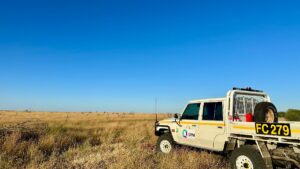How QEM’s Julia Creek Project can be a key player in the vanadium market

QEM’s Julia Creek project could be a real star for vanadium production. Pic: Getty Images.
- QEM scoping study demonstrates robust economics for the Julia Creek vanadium and oil shale project
- Project could deliver after-tax NPV of ~$1.1bn and IRR of 16.3% from the production of vanadium and transport fuels
- Life of mine revenue estimated at ~$21.7bn from production of 23.3Mlbs V2O5 and 313 million litres of fuel per annum
Special Report: QEM’s scoping study has outlined robust economics for its unique Julia Creek vanadium and oil shale project in Queensland along with an absence of issues that might prevent it from moving to the pre-feasibility stage.
The project is expected to deliver vanadium revenue over the life of mine totalling $11.5bn and about $10.1bn from the sale of transport fuel, generating post-tax net present value and internal rate of return – both measures of profitability – of ~$1.1bn and 16.3% respectively.
QEM (ASX:QEM) estimates pre-production capital expenditure at AUD$719m excluding contingency costs and indirect costs whilst estimating payback at about five years from the start of mining.
Julia Creek has a production target of about 10,571t (23.3Mlbs) of vanadium pentoxide and 313 million litres of transport fuel per annum over the estimated 30-year life of mine.
The company also expects mineralisation to be sourced from a single shallow, open-cut pit with an average steady state annual mining schedule target of ~5.1Mt at 0.27% V2O5 and 54.1 litres/tonne of in situ crude oil contained in shale.
While most of the world’s vanadium production is currently earmarked for making steel products, the critical mineral is seeing increasing use for producing the electrolyte used in vanadium flow batteries which have tremendous potential to backup electricity grids.
Guidehouse Insights forecasted in 2022 that global annual deployments of VFBs will grow at a compound annual growth rate of 41% to reach ~32.8GWh in 2031.
The ability to produce transport fuel such as diesel is also valuable as Australia relies almost entirely on imports to meet domestic consumption.
Sensitives across a range of +/- 15% on product selling price, capital and operating costs, and product output. Pic: QEM
A significant milestone
“This study represents a significant milestone for the company and the Julia Creek project,” managing director Gavin Loyden said.
“For the first time, we have detailed initial financial analysis to complement the technical and exploration achievements we’ve made to date.
“We are seeking to develop a major, long-life of mine project at Julia Creek and this study clearly articulates the potential that exists at our flagship project and reaffirms our ambition to become a key player in the long-duration vanadium battery storage market.”
Chairman Tim Wall added that the multi-commodity nature of Julia Creek demonstrates strong revenue potential while the “technical solutions presented enable capital efficient mining, on-site processing and refining to produce high purity Vanadium with a compelling investment proposition”.
In conjunction with reaching the significant Scoping Study milestone, the company advised that non-executive director David Fitch, who also strengthened its financial position as its largest shareholder, has resigned as a non-executive director with effect from August 27, 2024.

Julia Creek project. Pic: QEM
A world-class vanadium, oil shale project
Julia Creek consists of four granted exploration permits for minerals covering a total area of ~250km2 which cover part of the vast Toolebuc Formation.
It is considered to be one of the single largest ASX-listed vanadium deposits with overall resources of 2.87Bt grading 0.31% V2O5.
Of particular interest is the hefty indicated resources of 461Mt at 0.29% V2O5, which has enough certainty for mine planning. About 80% of this indicated resource feeds into the 30-year mining schedule.
The project also has an accompanying maiden 1C resource of 6.3 barrels of oil contained within the same ore body, 2C contingent resource of 94 million barrels, as well as a 3C resource of 654 million barrels..
It is situated just 6km from the Julia Creek township, which is a hub for the surrounding agricultural and mining activities and is accessible via the Flinders Highway, rail and Julia Creek airport.
Notably, it is supported by the critical minerals strategies published by both the Australian Federal and Queensland State Governments, which target the accelerated development of critical minerals projects to produce minerals such as vanadium that are required for sustainable supply chains and in addressing the energy transition.
Project funding
QEM plans to progress project funding options during the pre-feasibility study stage, noting that to achieve the outcomes indicated in the scoping study, it would require ~$20m for studies and evaluation along with pre-production capital expenditure of $1.095bn inclusive of contingency costs and indirect costs.
As such, it believes that it will be necessary to seek to access multiple funding streams to progress Julia Creek to the next stage and is now actively exploring additional initiatives.
One such initiative was the sale of a large-scale renewables project adjacent to Julia Creek to Enel Green Power Australia (EGPA) in January this year.
This yielded an upfront payment of $3m and has the potential to deliver another $4m in staged payments that will be made subject to the satisfaction of various conditions as well as a final payment when EGPA making a final investment decision which is contingent on the mix of renewable technologies selected.
QEM will also receive a revenue-based royalty of 1-2%, as well as energy offtake rights to supply its mine operations.
This potential revenue-based royalty stream may represent a possible saleable asset to assist in funding the continued development of the project.
This article was developed in collaboration with QEM, a Stockhead advertiser at the time of publishing.
This article does not constitute financial product advice. You should consider obtaining independent advice before making any financial decisions.
Related Topics
UNLOCK INSIGHTS
Discover the untold stories of emerging ASX stocks.
Daily news and expert analysis, it's free to subscribe.
By proceeding, you confirm you understand that we handle personal information in accordance with our Privacy Policy.








